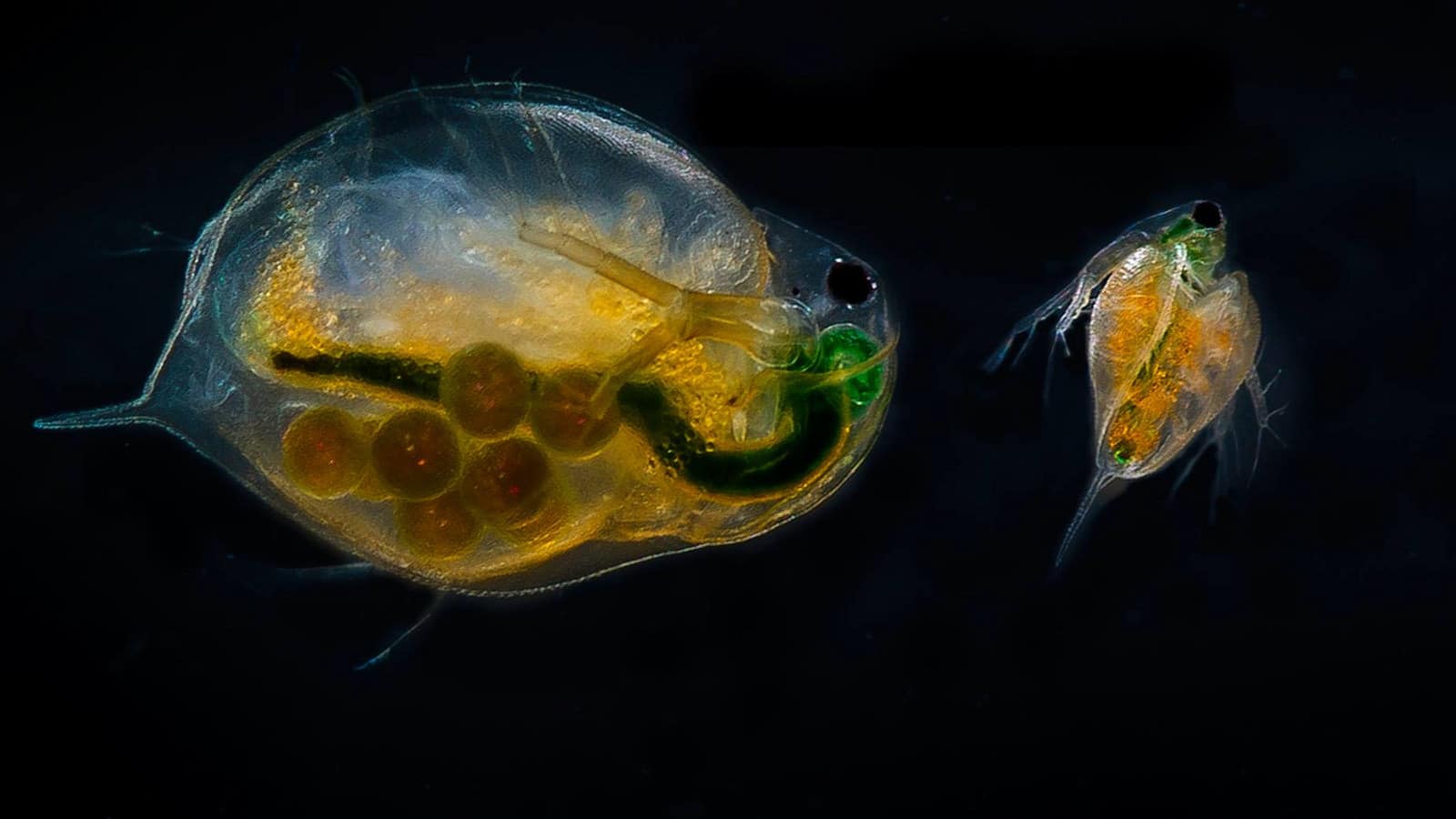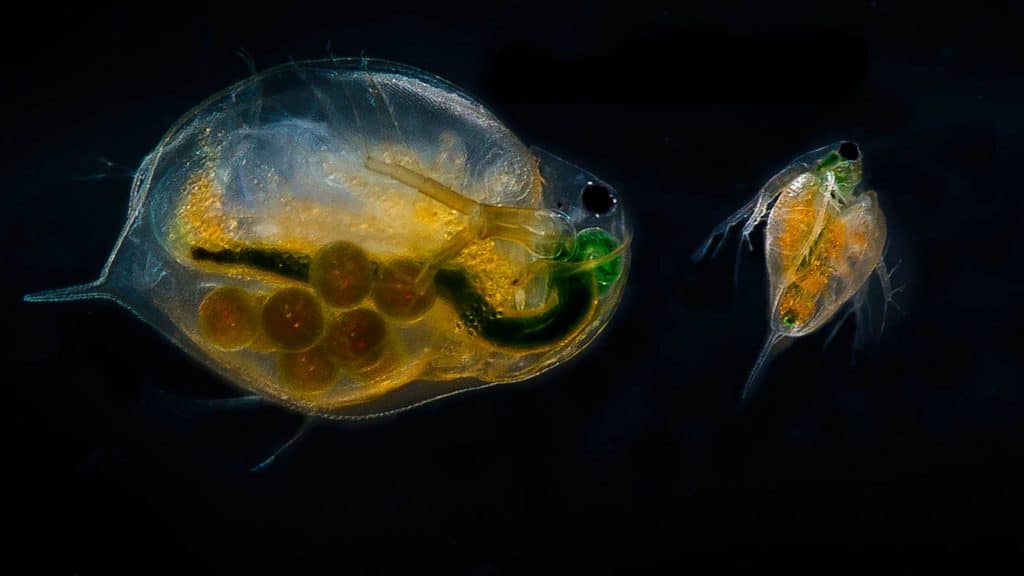Daphnia, or water fleas, are tiny plankton-like freshwater crustaceans that make an excellent food source for aquarium fish, fish fry, amphibians, and some invertebrates. You can keep large groups of these creatures in a small tank and harvest them whenever you want to feed your fish a nutritious treat.
If you fancy raising daphnia as a fresh, continuous food supply for your fish, read this article to learn how to do it!
What Size Daphnia Is Best for Culturing?
There are many different species of daphnia, and the size you raise depends on your specific goals and what you want the creatures for. However, smaller species of daphnia are generally more popular for culturing.
How so?
- Smaller daphnia species typically reproduce at a faster rate than larger ones. That means you can raise a large population of daphnia very quickly, making it easier to maintain a sustainable culture.
- Smaller daphnia species don’t need as much space to grow as larger ones. So, a small species is a more practical option if you have a very small tank.
- Small daphnia varieties tend to offer better nutritional value than larger ones.
- Smaller species of daphnia are typically more readily available in the trade than large ones, making establishing and maintaining a population easier.
Generally, large daphnia species are more popular for scientific research projects than as a food source for pet fish.
How To Set up a Daphnia Tank
Setting up a daphnia tank is pretty straightforward, although there are a few important things to know before you get started.
Indoor or Outdoor Tank?
Although some daphnia breeders keep their tanks outdoors, I recommend housing your tank indoors for the following reasons:
- The temperature is more stable indoors.
- Mosquito eggs that aren’t eaten by the daphnia can morph into larvae and then into adult mosquitos – yuk!
- Invasive species, such as Copepods, can set up home in your outside daphnia tank, finding their way into your main setup when you feed your fish on harvested daphnia.
- Tank maintenance is more convenient and less hassle when you keep your tank indoors.
So, overall, it’s best to keep your daphnia breeding tank indoors.
Tank Size
You can keep daphnia in a freshwater tank as small as just 5 or 6 gallons, although much larger aquariums than that are also fine.
When choosing a daphnia tank, you want one that offers plenty of surface area and a shallow water depth. That helps to replicate the creatures’ natural habitat of large ponds and the like, so ideally, you want a rectangular, shallow tank.
Daphnia breeds incredibly rapidly and in huge numbers, but that can lead to population crashes, especially in small tanks that can’t handle the amount of waste the creatures produce. Generally, the larger the tank volume you have, the less likely it is that you’ll experience mass die-offs.
Tank Setup
You’ll need to include freshwater plants, such as duckweed, in the tank, as well as some shrimp or snails and algae. Daphnia prefers to inhabit the upper areas of the water column, especially juveniles and babies, and that can make the water appear cloudy and dirty when it’s clean.
The water temperature needs to be around 68o F, and you can make the water harder by including a Wonder Shell (available online and from good drug stores) that also acts as a de-chlorinator.
Be sure to use a de-chlorinator when carrying out tank maintenance, as chlorine and chloramine will kill your daphnia. You need to carry out partial water changes of 50% at least once a month, adding aged water from an existing tank if you have it.
Since daphnia is photosensitive, it helps to have your tank lights on 24/7, although that’s not ideal for other tank residents and is really just an option for daphnia-only tanks.
You don’t need to provide a substrate or tank decorations since the daphnia spends most of its time swimming close to the water’s surface, and the less clutter you have in the tank, the easier maintenance will be.
Aeration
Daphnia thrives and breeds more readily in a well-aerated tank, and I find that using a coarse air stone that produces a rapid rolling boil water agitation works really well. In addition, with the air stone positioned at one end of the tank, the daphnia can relocate to calmer waters if they want to.
Water quality is vital, so don’t allow the water to become stagnant. In the wild, daphnia lives in water with a constant flow, and replicating that in the tank will help to improve your yield.
In addition, aerating the water really helps to keep freshwater floating plants, such as duckweed, from taking over because the surface agitation created by the bubbles helps to keep the surface clear.
Tank Mates
If you have a large enough daphnia tank, it’s helpful to have a few tank mates for them, such as shrimp and snails, although you must be careful to choose varieties that don’t prey on daphnia!
These helpful aquatic animals will help to keep the tank clean by feeding on debris.
Daphnia Reproduction
Daphnia are excellent reproducers. Did you know that it takes just 8 days for a baby daphnia to reach sexual maturity and start breeding? That’s probably because the creature’s lifespan is only a couple of months, so it’s imperative that breeding starts as soon as possible.
Every daphnia adult produces ten offspring, so you can see just how quickly a colony’s numbers can swell.
What Does Daphnia Eat?

In their natural environment, daphnia food includes bacterial flora, algae, and other tiny plankton that are even smaller than them.
In captivity, you can feed your daphnia on dry active yeast that you’ll find in your local grocery store on the home baking aisle. All you need to do is mix the active yeast with a small amount of water to activate it and then feed this type of food as a solution to the daphnia by sprinkling it on the water’s surface.
You can also add a good dose of spirulina powder to the fish tank, which turns the tank water green and provides excellent nutritional content for the daphnia. Daphnia also eats algae, so it’s useful to allow some of the green stuff to grow around the tank; you’ll be amazed how quickly these tiny creatures will clear it!
How Often Should I Feed Daphnia?
How often you feed your daphnia depends on the condition of the water in your tank. Basically, when the water turns clear, you know it’s time to feed them.
How to Harvest Daphnia
The process of harvesting daphnia to feed your fish and other aquarium livestock is simple and relatively hassle-free.
You’ll need a fine mesh aquarium fish net and a small container to hold the daphnia once you’ve harvested it.
- Gently pass the net through the highest population densities of daphnia at the water surface to catch as much as you can. The daphnia is a pale brown color, making it easy to see how many you’ve caught in your net.
- Don’t make your scooping motion too fast, as that will disturb debris from the tank bottom.
- Once you’ve finished harvesting the daphnia, either feed them directly to your fish or transfer the daphnia to a small water jar for storage. Note that you can only keep the daphnia in the jar for an hour or so before they will begin dying off, and you can’t store them in your fridge, as the sudden change in temperature will kill them.
Don’t be afraid to harvest lots of daphnia. These tiny critters reproduce incredibly rapidly, and frequent harvesting can prevent population crashes, too.
Where to Buy Daphnia Eggs and Live Daphnia
You can buy live daphnia directly from your local fish store, and daphnia eggs and starter cultures are available online.
If you decide to buy live daphnia, make sure they are fresh and lively. The main issue with buying daphnia from fish stores is that parasites can sometimes be included in the bag with the daphnia, and if the daphnia has been in the store for a couple of days, it will quickly begin to die off.
Gender Differences in Daphnia
You don’t need to worry about having enough daphnia of both sexes to start your breeding program.
Daphnia reproduces both sexually and asexually, although there are visible differences between males and females. That said, the creatures are so tiny it’s incredibly difficult to determine gender without the aid of a microscope!
In some species, female daphnia is longer-bodied and rounded than males, although that’s not a reliable way of telling the two sexes apart, as there can be a considerable variation within a species.
Female daphnia have what’s called a brood pouch that can be seen close to the animal’s hind legs. The pouch is used for carrying and protecting eggs and isn’t present in male daphnia. Male daphnia has spines, hooks, or other specialized appendages on various parts of their bodies that they use to grasp onto females during mating. However, that can vary between species, and not every male has them.
As you can see, it’s not easy to tell the boys from the girls where daphnia is concerned! However, given the number of these little creatures you’ll have in your tank, there’s sure to be a good enough mixture of both sexes to guarantee you a breeding colony.
Final Thoughts
Did you enjoy our guide to raising daphnia in your home tank? If you did, please take a moment to hit the share button before you go!
Daphnia, or water fleas, are extremely easy to raise and harvest, and they make an excellent, nutritious food source for fish and some invertebrates.
How did your daphnia breeding project go? Tell us in the comments box below!


